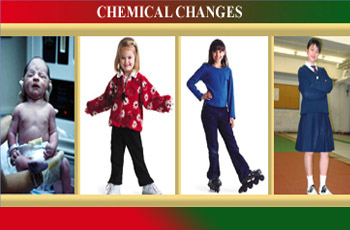 Life is a series of chemical changes
Life is a series of chemical changes
Chemicals are everywhere, all the substances in the world are chemicals. The rocks, the plants, the animals, all are made up of chemicals. Look around yourself. Ripening of a fruit, the changing of milk into curd, the digestion of food in our body, rusting of iron objects on exposure to damp air, growth of a child are some of the examples of chemical reactions.
When wood burns, heat is released. The end product is ash. This happens because the chemicals in the wood change on heating. The chemicals in the wood change into something different (ash) from wood.
The air we breathe is a mixture of gases such as oxygen, nitrogen, carbon dioxide and water vapor. These are chemicals. When food is digested in the stomach, the chemicals in the food undergo a series of reactions, to give us energy to live.
The water we drink, the food we eat, the clothes we wear, the buildings we live in, all are chemicals. Almost 65% of our body is water, the rest is made up of complex molecules such as proteins and lipids. They are also chemicals.
Plants are also made up of chemicals. In fact they are capable of mixing all the natural chemicals for their needs and they also make many new chemicals that we need. From plants we get food, medicines, fibers, fuel and many other useful chemicals.
When plants and animals die and get buried, over million years, their chemicals change to give us fossil fuels like petrol, diesel and gas. These changes arechemical reactions again!